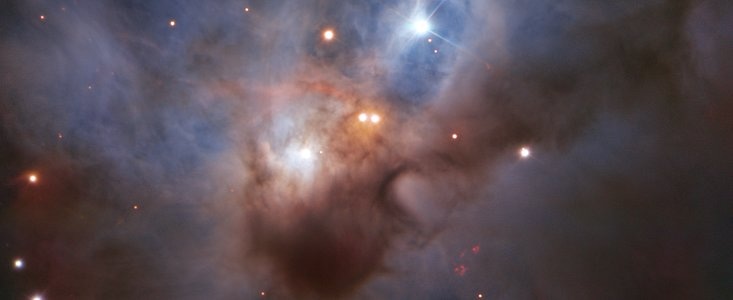Mar 15 2019
The Very Large Telescope (VLT) of ESO has successfully captured a picture of a ghostly nebula hidden deep into the darkest places of the constellation of Orion, or The Hunter—NGC 1788, labeled as the Cosmic Bat.
 Hidden in one of the darkest corners of the Orion constellation, this Cosmic Bat is spreading its hazy wings through interstellar space two thousand light-years away. It is illuminated by the young stars nestled in its core—despite being shrouded by opaque clouds of dust, their bright rays still illuminate the nebula. Too dim to be discerned by the naked eye, NGC 1788 reveals its soft colors to ESO’s Very Large Telescope in this image—the most detailed to date. (Image credit: ESO)
Hidden in one of the darkest corners of the Orion constellation, this Cosmic Bat is spreading its hazy wings through interstellar space two thousand light-years away. It is illuminated by the young stars nestled in its core—despite being shrouded by opaque clouds of dust, their bright rays still illuminate the nebula. Too dim to be discerned by the naked eye, NGC 1788 reveals its soft colors to ESO’s Very Large Telescope in this image—the most detailed to date. (Image credit: ESO)
Light is not produced by this bat-shaped reflection nebula, and instead, it is lighted up by a group of nascent stars in its core, only faintly seen through the dust clouds. Since the initial description of the NGC 1788, scientific instruments have advanced considerably, and this picture captured by the VLT is the most comprehensive image of this nebula to date.
Although this ethereal nebula in the constellation of Orion seems to be separated from other celestial objects, astronomers think that it was molded by intense [stellar winds]—from the giant stars beyond it. The upper atmosphere of a star throws these streams of scorching plasma at remarkable speeds, molding the clouds separating the young stars of the Cosmic Bat.
William Herschel, the German-British astronomer, first described NGC 1788, and he has even included this in a catalog, called the New General Catalogue, which subsequently acted as the basis for one of the most considerable collections of objects in the deep sky.
The MPG/ESO 2.2-meter telescope at ESO’s La Silla Observatory has already taken a nice image of this dim and tiny nebula; however, this recently visualized scene leaves it in the familiar dust.
The tiny details of the dusty wings of the Cosmic Bat, frozen in flight, were captured for the 20th anniversary of one of the most flexible instruments of ESO called the FOcal Reducer and low dispersion Spectrograph 2, or FORS2 for short.
The instrument, FORS2, is mounted on one of the VLT’s 8.2-metre Unit Telescopes, Antu¸ at the Paranal Observatory, and its potential to image huge sections of the sky in remarkable detail has made it a sought-after member of ESO’s range of sophisticated scientific instruments.
The FORS2 instrument, since its first light 20 years ago, was eventually recognized as “the Swiss army knife of instruments.” This nickname arises from it's exclusively set of functions.
The versatility of FORS2 even extends beyond purely scientific applications—its potential to capture such stunning, high-quality pictures makes it an indispensable tool for public outreach.
This picture was obtained as part of ESO’s outreach initiative—Cosmic Gems programme—that utilizes ESO telescopes to create pictures of intriguing, interesting, or visually appealing objects for public outreach and education purposes. The program also uses telescope time that otherwise cannot be applied to science observations, and with the help of the FORS2 instrument, creates incredible pictures of some of the most arresting objects present in the night sky, like this complex reflection nebula. Moreover, if the collected data show to be valuable for upcoming scientific purposes, such observations are saved and made available to astronomers via the ESO Science Archive.